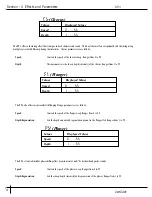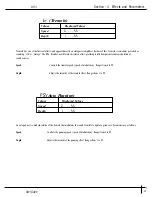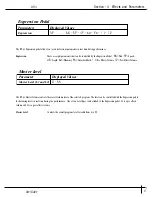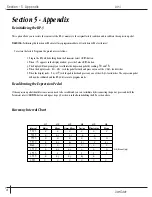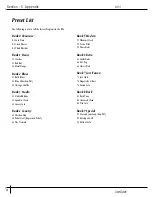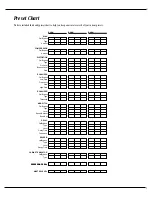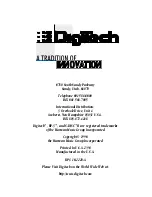
Ambience, or reverberation, is produced when sound energy is reflected off room surfaces and objects. Using reverb in recorded program
material gives the listener a sense that the material is being performed in an actual room or hall. It is this similarity to actual acoustic spaces
that makes reverberation a useful tool in recorded music. Reverb Parameters and their functions are as follows:
Reverb
Turns the Reverb effect on or off.
Type
Allows you to choose your ambience or setting you want to use. There are ten available type settings:
CL
=Club
HA
=Hall
St
=Studio
Ch
=Church
ro
=Room
Ar
=Arena
PL
=Plate
Sp
=Spring
gA
=Garage
Level
Controls the amount of reverb signal to be mixed in with the dry signal. Ranges from 0 to 99.
Decay Time
The amount of time it takes for the Reverb to fade to inaudibility. Ranges from 1 to 10.
The RP-3’s programmable Speaker Cabinet circuitry allows you to use it in both recording and live situations without lugging heavy amps
and/or cabinets around. Just connect the RP-3’s outputs to a mixing console and kick in the Speaker Cabinet. Parameters are as follows:
Cabinet
Turns the Cabinet Emulator on or off.
Type
Selects the tonal characteristics of the simulated cabinet. There are 9 different cabinet types; 1 being the
brightest and 9 being the darkest.
Note: When headphones are plugged in, the Speaker Cabinet Emulator is engaged globally on all programs. This will affect the
sound at the left and right main outputs.
Cabinet Emulator
Parameters
Displayed Values
On/Bypass
O n - B y
Type
1 . . . 9
Reverb
Parameters
Displayed Values
On/Bypass
Type
Level
O n - b y
C L . . . S P
0 . . . 9 9
Decay Time
1 . . . 1 0
Section - 4 Effects and Parameters
RP-3
User Guide
16
Содержание RP 3
Страница 6: ...RP 3 User Guide IV ...











